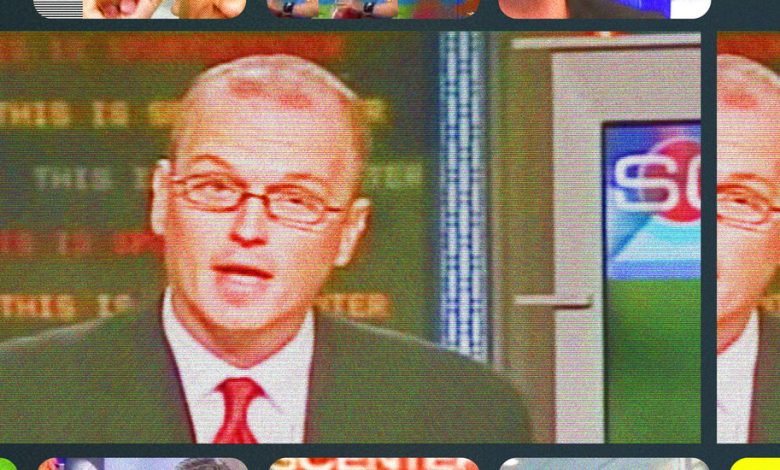Sports Anchors Went All In on Outrage. Then There’s Scott Van Pelt.

Scott Van Pelt materializes onscreen five nights a week at midnight — sometimes a little earlier or later — typically in a necktie and pocket square, the spotlight reflecting off his bald head, ready to talk about the day in sports. There will be highlights, analysis, commentary and, depending on when you tune in, maybe a funny bit. (On Mondays, he and his sidekick, Stanford Steve, deliver “Bad Beats,” a Letterman-style compilation of the plays behind the week’s most brutal gambling losses — the meaningless three-pointer at the buzzer that busted bettors on the “under,” the late fumble and pointless touchdown that prevented the winning team from “covering.”) Van Pelt likes to say that he just tries to be himself on air. If we take him at his word about that, it’s safe to say that he is thoughtful, wry, self-aware and occasionally sentimental. Also, that he is not aggressive, obnoxious or particularly opinionated, which makes him a rarity among today’s sports-media personalities.
Van Pelt is the anchor of the late-night edition of ESPN’s “SportsCenter,” the one made famous in the 1990s by Keith Olbermann and Dan Patrick. He has been the face of the show — once the network’s hottest franchise, now more of a comfort watch for sports fans of a certain disposition — for going on 10 years, even as the network and the entire sports-entertainment complex has simultaneously blown up and melted down around him. He is the last man standing amid a ceaseless and ongoing sports-media revolution.
Paradoxically, it was the late-night “SportsCenter” telecast that helped ignite this revolution in the first place. It’s impossible to overstate how big a deal the show was in its prime. Practically speaking, it was the only place to get all of the day’s sports scores and highlights. The staccato opening bars of its theme music — dah duh dah, dah duh dah! — were like a late dinner bell for sports fans. But “SportsCenter” was much more than a sports news show; it was a cultural phenomenon. The catchphrases that its hosts unspooled on the air — “En fuego,” “Cool as the other side of the pillow,” “Yahtzee!” — seeped into the broader culture, as did the patter-speak surrounding them.
“SportsCenter” was a tone and an attitude — droll, irreverent, fun — maybe best embodied by its cheeky, pitch-perfect commercials, usually filmed in ESPN’s generic corporate offices. (In my favorite, a bird-themed mascot carrying lunch bumps into the glass wall of a conference room, interrupting a meeting being run by the anchor Stuart Scott, who doesn’t flinch. Moments later, a different bird mascot does exactly the same thing. “Seriously,” Scott deadpans, “we have got to get this glass frosted.”) That tone and attitude would extend far beyond ESPN itself. “SportsCenter” created the archetype of the smart, fast-talking sports broadcaster that clearly inspired Aaron Sorkin’s first foray into television, the short-lived “Sports Night” — which is to say that dialogue we now think of as “Sorkinesque” owes a debt to Patrick and Olbermann. The language that would be branded as an aspirational kind of Americanese in “The West Wing” was gestated in the world of sports.
Most influentially, “SportsCenter” redefined “sports news” in much the same way that its neighboring cable channels redefined “news.” Games, like major news events, were relatively rare, at least when you needed to fill 24 hours of programming. But you could also entertain viewers with conversations about those games; those conversations might even be considered “news” themselves. To entertain viewers, though, ESPN needed its anchors to be entertaining — a tricky proposition for a network that was billing itself as the Worldwide Leader in Sports and was therefore a place where personalities had to remain subservient to the bigger brand. That brand was sports, not politics. Olbermann had been one kind of cable-TV star at ESPN; he became a very different one as the host of “Countdown With Keith Olbermann” on MSNBC.




